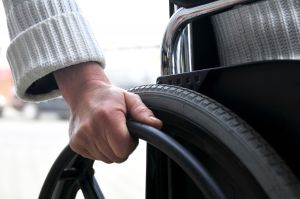Adaptive yoga is a growing field of therapy. While the general populace may see yoga as a series of impossible and strange contortions, the truth of the matter is that yoga can gently produce flexibility and strength where there was none before.

Personal Limitations
The limitations of an individual will determine the extent of his therapies. Some of the purposes of rehabilitation for someone with MS, for example, is to lessen the patient’s fatigue, improve general conditioning, and to help the patient feel and function better. This is typically done through physical therapy, in which the patient works on exercises to develop strength, improve posture, control pain, and improve balance. PT will include stretching and range of motion exercises, as well as strengthening exercises.
However, these same goals can be achieved through adaptive yoga. Since people with MS tend to have more problems when they get too hot, the stretching exercises are slower, and the instructor has the patient focus on relaxation and breathing. In adaptive yoga classes, each person is proceeding at a different pace. Participants say they receive the personalized guidance from the instructors, but don’t feel like they “stick out” if they can’t do it right.
Pain Management

Pain management for many different health problems can be quite difficult. Whether the problem is a disease or an injury, different pain therapies may or may not work. Medication is always useful, and there are many excellent pain medicines on the market, but they often have bad side effects.
With adaptive yoga, patients gently stretch muscles that they normally stretch on their own, through the help of an instructor. Just as with PT, the person will find that he has increased mobility in his joints and more muscle strength. In addition, the person will learn how to breathe deeply and relax, which is very helpful in pain management. In some forms of adaptive yoga, the patient will learn how to isolate different sensations of pain, and proceed to relieve the pain. Patients also learn how to become aware of tightness or numbness in parts of the body. The exercises will increase circulation as well, helping to reduce inflammation and carry toxins away.
Slow Down
Most people who come to adaptive yoga classes find that the classes help them to manage their symptoms much more effectively. They find that, rather than pressure and the need to “keep up” as they would in a gym class, yoga class is self-paced and non-judgmental. In addition, rather than the clinical setting you find yourself in with many traditional therapies, yoga is more like a regular workout. You learn to slow down and focus your senses on your body, learning to control various sensations and your responses to them. When you combine those benefits with increased joint flexibility and improved muscle tone, you have a great way to keep moving and rehabilitate.
Slow down with adaptive yoga, and you’ll find you have more inner strength as well as muscular strength.
[toggle title=”Featured images”]
 License: Creative Commons image source
License: Creative Commons image source License: Creative Commons image source
License: Creative Commons image source
[/toggle]
Laura Green loves to practice yoga, she enjoys trying to keep her fitness levels high and writes about her progress. When she isn’t writing you can usually find her working for a company that provide yoga teacher training.

Leave a Reply